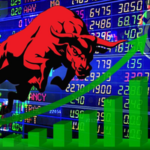Global financial markets faced renewed volatility this week as escalating trade tensions between the United States and China rattled investor sentiment, affecting commodities like oil and gold, and triggering sharp losses across major US indices.
Oil Markets Slide Amid Fears of Global Slowdown
Crude oil prices remain under pressure following a 13% drop last week, as concerns grow over the long-term impact of the US-China trade war on global economic growth and trade volumes. Investors are increasingly wary of disruptions to trading routes and slower demand.
The analysis by Vijay Valecha, Chief Investment Officer, Century Financial, mentioned, Brent crude is currently trading below its 9-day simple moving average (SMA), facing immediate resistance at $66.11 and support at $62.30. Similarly, West Texas Intermediate (WTI) is trading below its 9-day SMA, with resistance seen at $62.20 and support at $59.50.
Gold Surges to Record High on Safe-Haven Demand
Gold soared past $3,200 per ounce on Friday, fueled by a weakening US dollar and heightened safe-haven buying amid the deteriorating trade relationship between Washington and Beijing. The greenback slid nearly 1% against major currencies, making gold more affordable for foreign investors.
Bullion is trading above the 9-day SMA on the 4-hour chart. Immediate resistance lies at the $3,250 mark, while support is expected around $3,190.
Gold Prices in UAE (April 11, 2025):
- 24 Carat – AED 386.50
- 22 Carat – AED 358.00
- 21 Carat – AED 343.25
- 18 Carat – AED 294.25
US Markets Sink as Investors Brace for Economic Uncertainty
Wall Street ended the week on a sour note, with the Nasdaq Composite falling 4.3% and the S&P 500 losing 3.5%, amid deepening worries over trade policy and economic growth. Investors were spooked after President Trump confirmed a tariff hike to 145% on Chinese imports, adding a new 125% tariff on top of previous 20% duties.
Adding to the uncertainty, US consumer prices unexpectedly dropped to 2.4% year-on-year in March, leading to increased expectations that the Federal Reserve could resume rate cuts starting in June. Some market watchers now predict a full percentage point cut before year-end.
Airlines, hotels, and gasoline prices declined last month, indicating weaker consumer demand. Delta Air Lines, citing economic ambiguity, chose not to provide full-year financial guidance—further unsettling the market.
The S&P 500, currently up 1.2% at $5,331, finds support at the 50-SMA ($5,286) and 21-SMA ($5,185) on the 4-hour chart, with potential resistance at the 100-SMA level of $5,483.
Earnings Season Begins Under a Cloud of Uncertainty
As big banks like JPMorgan Chase, Morgan Stanley, Wells Fargo, BlackRock, and Bank of New York Mellon kick off the Q2 earnings season, investors will closely monitor management guidance for clues on how companies are preparing for continued macroeconomic headwinds.
With geopolitical risks rising and economic indicators softening, markets are likely to remain volatile in the short term.






